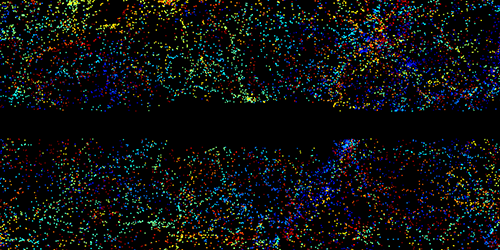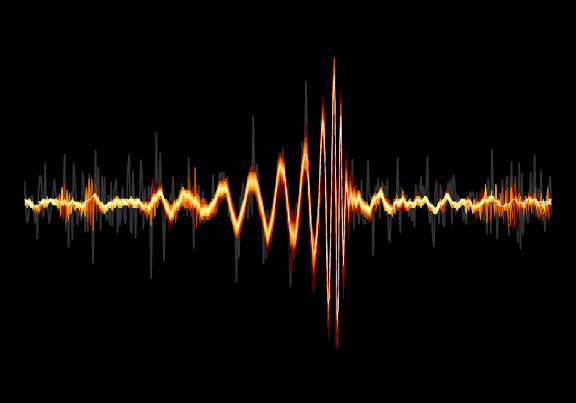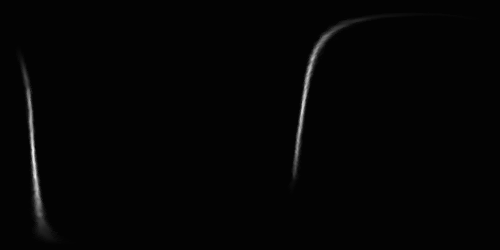


The 2MASS Galaxy Reshift Survey measured the positions of 40,000 galaxies across the whole sky. The colours of the galaxies denote their distance, highlighting the clusters and networks threading through the cosmos. The most distant galaxies in the image are at a redshift of around 0.2, corresponding to a distance of around 2.7 billion light years, though the colour scale (shown below) saturates at small and large distances (for clarity). The survey works in near-infrared light, and so is able to see through more of the galactic dust than optical images. However, there is a strip across the middle where our own galaxy is still in the way.
For more information about the survey, please see Huchra et al. (2012) APJs 199 26.


GW150914 was the first ever gravitational wave signal directly observed, and was detected by the twin LIGO detectors in the United States. The source was the coalescence of two black holes, each around 30 times the mass of the Sun, making this the first observational evidence of a stellar-mass binary black hole.
The signal arrived at LIGO Livingston around 7 milliseconds before it arrived at LIGO Hanford, allowing its position to be constrained largely to the Southern Hemisphere. Although its possible locations appear to include the Large Magallenic Cloud, its distance of 1.4 billion light years means that it originated much further away, likely in a distant galaxy. Additional information contained in the signal, such as the relative amplitude observed at each observatory, means that the localization is restricted largely to one part of the sky, rather than a complete ring.

GW151226 was the second most significant source detected in Advances LIGO's first observing run. The source was the coalescence of two black holes, one of which was 5-10 times the mass of the Sun and the other roughly double that.
The signal arrived at LIGO Livingston around 1 millisecond before it arrived at LIGO Hanford, allowing its position to be constrained to segments of a single ring around the sky. Its distance of around 1.4 billion light years means that it originated in a distant galaxy. Because the signal was weaker, many of the properties of this system are less well constrained compared with the first detection (GW150914).

LVT151012 is the third most significant gravitational wave candidate signal discovered by Advanced LIGO in the first observing run (Sept 2015-Jan 2016). It was detected by the twin LIGO detectors in the United States, but not with enough certainty to be declared a definite detection, though the probability of it being a false alarm is 5%. If real, the source was the coallescence of two black holes of around 23 and 13 times the mass of the Sun. Due to the weak signal compared with the noise, these masses estimates have significant uncertainty
The signal arrived at LIGO Hanford around 1 millisecond before it arrived at LIGO Livingston, allowing its position to be constrained to two segments of a single ring around the sky. Its distance of around 3.3 billion light years means that it originated in a distant galaxy. Compared with much lower signal-to-noise ratio, the properties of the system are less well constrained than for the other two detection in the first observing run.

GW170104 was the first gravitational wave signal discovered in the second observing run of Advanced LIGO, and was detected by both of the twin LIGO detectors in the United States. The source was the coalescence of two black holes, which were about 20 and 30 times the mass of the Sun.
The signal arrived at LIGO Hanford around 3 millisecond before it arrived at LIGO Livingston, allowing its position to be constrained to segments of a ring around the sky. Its distance of around 2.9 billion light years means that it originated in a distant galaxy.

GW170814 was the first gravitational wave signal detected by three detectors - the two Advanced LIGO detectors and the Advanced Virgo detector near Pisa, Italy. The source was the coalescence of two black holes, which were about 20 and 30 times the mass of the Sun.
Because the signal was detected by three detectors, its location on the sky is much better known than previous sources reduced to just 60 deg2 with the addition of Virgo.

GW170817 was the first ever detected merger of a binary neutron star, which resulted in a burst of gravitational waves as well as electromagnetic radiation across many wavelengths. The detection was localised to 28 deg2 by the three gravitational wave detectors, but follow-up observations by optical telescopes narrowed the location down to a galaxy called NGC 4993.